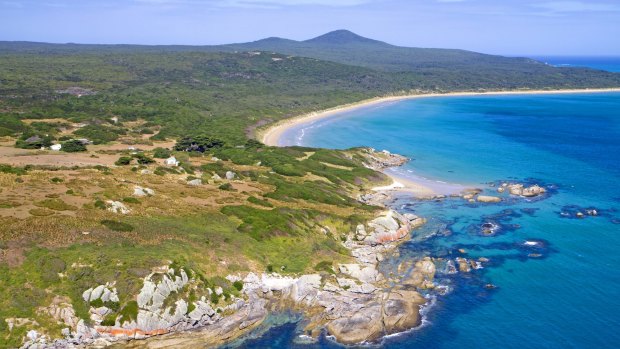This was published 9 years ago
Three Hummock Island accommodation
Life has a different pace on Three Hummock Island, but some social norms are universal.
By Elspeth Callender

Wild side: Three Hummock Island, off Tasmania's northwest tip.Credit: Getty Images
Every place in Australia has its own way of greeting new arrivals to the neighbourhood. In Coonabarabran it's an oven-warm cinnamon teacake brought to your front door, in Northcote a jar of homemade plumcot jam might be passed over the side fence and in Fannie Bay you're sure to have a cold beer thrust into your hand. If you're new on Three Hummock Island (and they like you), a welcoming gift will be left for you on the mat. And remember to smile when you open the door and find it there because they'll all be watching you.
Three Hummock Island, off north-west Tasmania, is almost void of human life these days, yet the fauna is so abundant that you'll never feel alone. Forester kangaroos graze on the vast marsupial lawn surrounding the island's accommodation, although they're shy creatures. And those purple swamphens - reputedly into co-operative breeding groups - are far too alternative to conform to social niceties. So it's left to the Cape Barren geese to make the effort, which they do while you're sleeping so as not to disturb.
Before European settlement, Aboriginal people of the North West groups would swim from mainland Tasmania to Three Hummock to hunt in summer. In 1798 Bass and Flinders turned up, claimed the 7400-hectare island for Britain and renamed it in honour of its three humpy bumps. Since the mid-1800s a 40-acre pastoral lease has existed on the snout of what looks, on a satellite image, like a west-facing pig's head. In true frontier fashion, all sorts of wildly ambitious ventures have been pursued on this land irrespective of environmental suitability: someone tried and failed to develop a racehorse breeding industry, and Granite Hill is today grazed by friendly feral sheep whose ancestors failed to sufficiently flourish.
The workers' cottage in which I chose to stay was brought to the island in 1910 as a prefab and is the quainter and smaller of the two accommodation options. Like the nearby homestead of the same vintage, the cottage has wooden floorboards and timber-lined walls but is far more basic, with an endearingly daggy kitchen and bathroom. Most visitors to Three Hummock stay in the homestead, with its refurbished kitchen, indoor toilet, barbecue on the deck and proximity to the ocean, yet I suspect the geese are impressed by my rustic sensibilities.
The land beyond the 16-hectare lease is state reserve, but the two managers - the only permanent human residents of Three Hummock - treat it as a natural extension of their responsibilities by keeping walking tracks cleared and driving guests wherever they want to go. At night the O'Briens retreat to the island's most contemporary residence, built in 1940.
On the first evening, I bathe in water pumped from the island's fresh spring and think about what I've already seen of this extraordinary place; the views from South Hummock, a muttonbird rookery, hidden wetland, flourishing vegetable garden, historic jetty, sheltered bays, massive lichened boulders, long wild beaches, giant sand dunes. Outside, the wildlife makes the occasional wild noise, then it is back to absolute silence.
The next morning, as I'm on my way out the back door, I realise that every head on the marsupial lawn is turned towards me. I look down and there it is: a very large fresh lump of goosiness deposited directly on the doormat. Too kind.
The writer was a guest of Three Hummock Island with support from Tourism Tasmania.
Sign up for the Traveller Deals newsletter
Get exclusive travel deals delivered straight to your inbox. Sign up now.